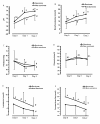Severe metabolic or mixed acidemia on intensive care unit admission: incidence, prognosis and administration of buffer therapy. A prospective, multiple-center study
- PMID: 21995879
- PMCID: PMC3334789
- DOI: 10.1186/cc10487
Severe metabolic or mixed acidemia on intensive care unit admission: incidence, prognosis and administration of buffer therapy. A prospective, multiple-center study
Abstract
Introduction: In this study, we sought describe the incidence and outcomes of severe metabolic or mixed acidemia in critically ill patients as well as the use of sodium bicarbonate therapy to treat these illnesses.
Methods: We conducted a prospective, observational, multiple-center study. Consecutive patients who presented with severe acidemia, defined herein as plasma pH below 7.20, were screened. The incidence, sodium bicarbonate prescription and outcomes of either metabolic or mixed severe acidemia were analyzed.
Results: Among 2, 550 critically ill patients, 200 (8%) presented with severe acidemia, and 155 (6% of the total admissions) met the inclusion criteria. Almost all patients needed mechanical ventilation and vasopressors during their ICU stay, and 20% of them required renal replacement therapy within the first 24 hours of their ICU stay. Severe metabolic or mixed acidemia was associated with a mortality rate of 57% in the ICU. Delay of acidemia recovery as opposed to initial pH value was associated with increased mortality in the ICU. The type of acidemia did not influence the decision to administer sodium bicarbonate.
Conclusions: The incidence of severe metabolic or mixed acidemia in critically ill patients was 6% in the present study, and it was associated with a 57% mortality rate in the ICU. In contradistinction with the initial acid-base parameters, the rapidity of acidemia recovery was an independent risk factor for mortality. Sodium bicarbonate prescription was very heterogeneous between ICUs. Further studies assessing specific treatments may be of interest in this population.
Figures


References
Publication types
MeSH terms
Substances
LinkOut - more resources
Full Text Sources
Medical
Miscellaneous

